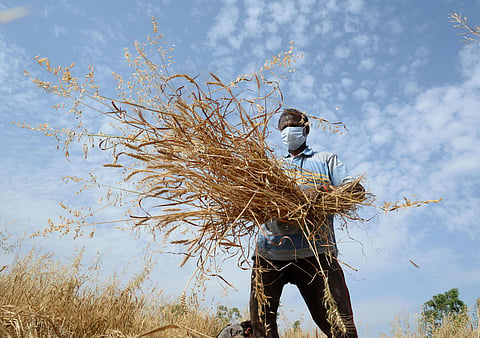

The India Meteorological Department (IMD) has issued an advisory to farmers of Punjab, Haryana, and Rajasthan that their rabi crops will be affected due to abnormally rising temperature in February. It has advised mild irrigation and other practices to maintain soil moisture.
IMD has pointed out that the major reason behind maximum temeprature is due to absence of any active western disturbance (WD) in February. WD brings rain in North-West and Central India and snowfall at higher altitudes. Farmers expect February rain as it is useful for rabi crops such as wheat. Like the last year, the early arrival of heatwave in March caused a sharp reduction in wheat production, consequently causing food inflation.
“This is a terrible development that a heatwave-like situation prevails in February is a matter of concern for food production,” said an IMD scientist. IMD advised farmers to check soil moisture.
Punjab and Haryana are considered the food bowl of the country. Lesser production of rabi crops, especially wheat, would further accentuate wheat and atta price. The government has already been trying to cool down the price of wheat and atta by selling 30 lakh tonnes of wheat in the open market and continuing the policy of an export ban on wheat.
This higher day temperature might adversely affect wheat as the wheat crop is approaching reproductive growth period, which is sensitive to temperature. High temperature during the flowering and maturing period leads to a loss in yield. There could be a similar impact on other standing crops and horticulture.
In its advisory, Light irrigation can be provided if the crop appears to be under stress. To reduce the impact of higher temperatures, add mulch material in the space between two rows of vegetable crops to conserve soil moisture and maintain the soil temperature.
Different parts of the country is facing abnormally higher temperature in the month of February, especially in western region like Gujarat, Maharashtra, Western Rajasthan. Even Delhi’s Safdarjung Airport has experienced the third highest temperature (33.6 degrees celsius) in the past 55 years (between 1969 and 2023), and it is 9 degrees C higher than normal temperature.
Maximum temperatures in the range of 35-39°C prevailed over many parts of Gujarat, Rajasthan and Konkan and Goa, coastal Karnataka during past week (13-20 Feb 2023) and currently, it is above normal by 4-9°C.
They are above normal by 6-9°C over some areas of Saurashtra and Kutch and southwest Rajasthan. The maximum temperature in the range of 23-28°C over parts of Himachal Pradesh and Uttarakhand from 15 to 20 Feb 2023 and above normal by 5-11°C. Over Punjab, Haryana, Chandigarh and Delhi, it has reached upto 28-33°C during 18-20 Feb and it is also above normal by 5- 9°C.
IMD also pointed out that Anti-cyclone over south Gujarat and weaker sea breeze and stronger land breeze over the Konkan coast are other major reasons for maximum temperature.